语言学期终考试复习提纲
语言学复习提纲
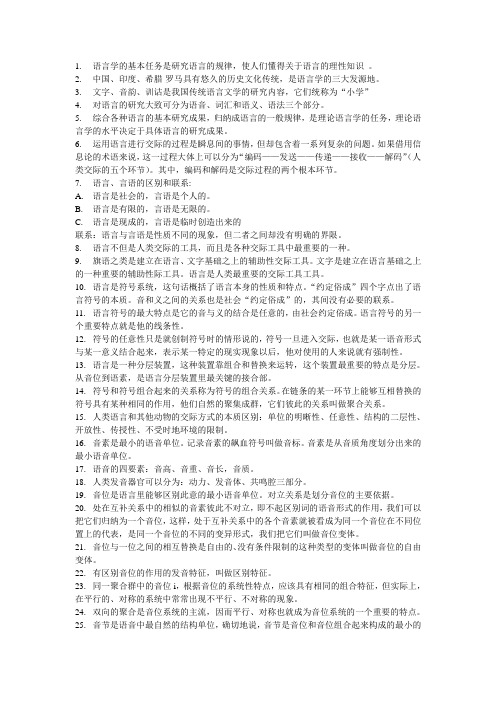
1. 语言学的基本任务是研究语言的规律,使人们懂得关于语言的理性知识。
2. 中国、印度、希腊-罗马具有悠久的历史文化传统,是语言学的三大发源地。
3. 文字、音韵、训诂是我国传统语言文学的研究内容,它们统称为“小学”4. 对语言的研究大致可分为语音、词汇和语义、语法三个部分。
5. 综合各种语言的基本研究成果,归纳成语言的一般规律,是理论语言学的任务,理论语言学的水平决定于具体语言的研究成果。
6. 运用语言进行交际的过程是瞬息间的事情,但却包含着一系列复杂的问题。
如果借用信息论的术语来说,这一过程大体上可以分为“编码——发送——传递——接收——解码”(人类交际的五个环节)。
其中,编码和解码是交际过程的两个根本环节。
7. 语言、言语的区别和联系:A. 语言是社会的,言语是个人的。
B. 语言是有限的,言语是无限的。
C. 语言是现成的,言语是临时创造出来的联系:语言与言语是性质不同的现象,但二者之间却没有明确的界限。
8. 语言不但是人类交际的工具,而且是各种交际工具中最重要的一种。
9. 旗语之类是建立在语言、文字基础之上的辅助性交际工具。
文字是建立在语言基础之上的一种重要的辅助性际工具。
语言是人类最重要的交际工具工具。
10. 语言是符号系统,这句话概括了语言本身的性质和特点。
“约定俗成”四个字点出了语言符号的本质。
音和义之间的关系也是社会“约定俗成”的,其间没有必要的联系。
11. 语言符号的最大特点是它的音与义的结合是任意的,由社会约定俗成。
语言符号的另一个重要特点就是他的线条性。
12. 符号的任意性只是就创制符号时的情形说的,符号一旦进入交际,也就是某一语音形式与某一意义结合起来,表示某一特定的现实现象以后,他对使用的人来说就有强制性。
13. 语言是一种分层装置,这种装置靠组合和替换来运转,这个装置最重要的特点是分层。
从音位到语素,是语言分层装置里最关键的接合部。
14. 符号和符号组合起来的关系称为符号的组合关系。
语言学纲要期末复习资料.doc
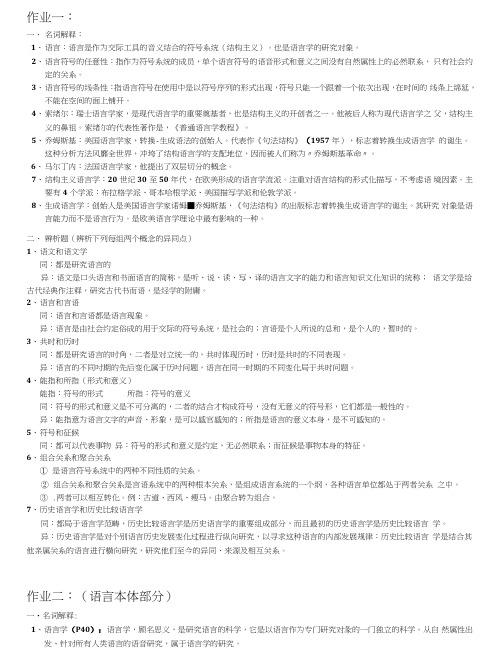
作业一:一、名词解释:1、语言:语言是作为交际工具的音义结合的符号系统(结构主义)。
也是语言学的研究对象。
2、语言符号的任意性:指作为符号系统的成员,单个语言符号的语音形式和意义之间没有自然属性上的必然联系,只有社会约定的关系。
3、语言符号的线条性:指语言符号在使用中是以符号序列的形式出现,符号只能一个跟着一个依次出现,在时间的线条上绵延,不能在空间的面上铺开。
4、索绪尔:瑞士语言学家,是现代语言学的重要奠基者,也是结构主义的开创者之一。
他被后人称为现代语言学之父,结构主义的鼻祖。
索绪尔的代表性著作是,《普通语言学教程》。
5、乔姆斯基:美国语言学家,转换-生成语法的创始人。
代表作《句法结构》(1957年),标志着转换生成语言学的诞生。
这种分析方法风靡全世界,冲垮了结构语言学的支配地位,因而被人们称为〃乔姆斯基革命〃。
6、马尔丁内:法国语言学家,他提出了双层切分的概念。
7、结构主义语言学:20世纪30至50年代,在欧美形成的语言学流派。
注重对语言结构的形式化描写,不考虑语境因素。
主要有4个学派:布拉格学派、哥本哈根学派、美国描写学派和伦敦学派。
8、生成语言学:创始人是美国语言学家诺姆■乔姆斯基,《句法结构》的出版标志着转换生成语言学的诞生。
其研究对象是语言能力而不是语言行为。
是欧美语言学理论中最有影响的一种。
二、辨析题(辨析下列每组两个概念的异同点)1、语文和语文学同:都是研究语言的异:语文是口头语言和书面语言的简称,是听、说、读、写、译的语言文字的能力和语言知识文化知识的统称;语文学是给古代经典作注释,研究古代书而语,是经学的附庸。
2、语言和言语同:语言和言语都是语言现象。
异:语言是由社会约定俗成的用于交际的符号系统,是社会的;言语是个人所说的总和,是个人的,暂时的。
3、共时和历时同:都是研究语言的时角,二者是对立统一的,共时体现历时,历时是共时的不同表现。
异:语言的不同吋期的先后变化属于历吋问题,语言在同一时期的不同变化局于共时问题。
语言学复习提纲

1. Synonymy ref ers to the sameness or close similarity of meaning.2. The grammatical meaning of a sentence ref ers to its grammaticality, i.e., its grammatical well-f orm edness. The grammaticality of a sentence is governed by the grammatical rules of the language.3. Connotative meaning is what is communicated by virtue of what language refers to.4. Antonymy ref ers to the relation of oppositeness of meaning.5. An illocutionary act is the act of expressing the speaker’s intention; it is the act perf ormed in saying something.6. V owel is a major category of sound segments, produced without obstruction of the vocal tract so that air escapes in a relatively unimpeded way through the mouth or the nose7. Bound morpheme ref ers to those which cannot occur alone and must appear with at least one other morpheme.8. Consonant is a major category of sound segments, produced by a closure in the vocal tract, or by narrowing which is so marked that air cannot escape without producing audible f riction.9. Perlocutionary act concerns the consequential eff ects of a locution on hearer.10. Displacement is the ability of language to refer to context removed from the speaker’s immediate situation.11. Componential analysis is a way to analyze word meaning. It was proposed by structural semanticists. The approach is based on the belief that the meaning of a word can be divided into meaning components, which are called semantic f eatures.12. Context consists of the knowledge that is shared by the speak er and the hearer. The shared knowledge is of two types: the knowledge of the language they use, and the knowledge about the world, including the general knowledge about the world and the specif i c knowledge about the situation in which linguistic communication is taking place.13. The meaning of an utterance is concrete, and context-dependent. Utterance is based on sentence meaning; it is realization of the abstract meaning of a sentence in a real situation of communication, or simply in a context.14. The meaning of a sentence is of ten considered as the abstract, intrinsic property of the sentence itself in terms of a predi cation.15. Performatives were sentences that did not state a f act or describe a state, and were not verif iabl e. Their f unction is to perf orm a particular speech act.1、语言学的主要分支是什么。
语言学概论期末复习重点
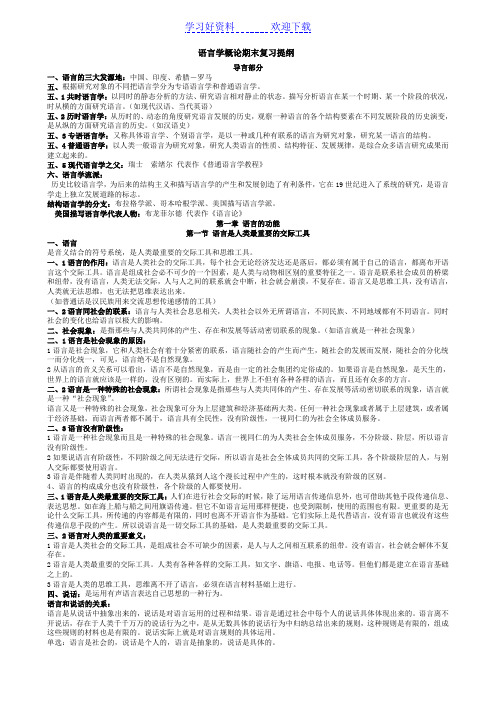
语言学概论期末复习提纲导言部分一、语言的三大发源地:中国、印度、希腊-罗马五、根据研究对象的不同把语言学分为专语语言学和普通语言学。
五、1共时语言学:以同时的静态分析的方法、研究语言相对静止的状态。
描写分析语言在某一个时期、某一个阶段的状况,时从横的方面研究语言。
(如现代汉语、当代英语)五、2历时语言学:从历时的、动态的角度研究语言发展的历史,观察一种语言的各个结构要素在不同发展阶段的历史演变,是从纵的方面研究语言的历史。
(如汉语史)五、3专语语言学:又称具体语言学、个别语言学,是以一种或几种有联系的语言为研究对象,研究某一语言的结构。
五、4普通语言学:以人类一般语言为研究对象,研究人类语言的性质、结构特征、发展规律,是综合众多语言研究成果而建立起来的。
五、5现代语言学之父:瑞士索绪尔代表作《普通语言学教程》六、语言学流派:历史比较语言学,为后来的结构主义和描写语言学的产生和发展创造了有利条件,它在19世纪进入了系统的研究,是语言学走上独立发展道路的标志。
结构语言学的分支:布拉格学派、哥本哈根学派、美国描写语言学派。
美国描写语言学代表人物:布龙菲尔德代表作《语言论》第一章语言的功能第一节语言是人类最重要的交际工具一、语言是音义结合的符号系统,是人类最重要的交际工具和思维工具。
一、1语言的作用:语言是人类社会的交际工具,每个社会无论经济发达还是落后,都必须有属于自己的语言,都离布开语言这个交际工具。
语言是组成社会必不可少的一个因素,是人类与动物相区别的重要特征之一。
语言是联系社会成员的桥梁和纽带,没有语言,人类无法交际,人与人之间的联系就会中断,社会就会崩溃,不复存在。
语言又是思维工具,没有语言,人类就无法思维,也无法把思维表达出来。
(如普通话是汉民族用来交流思想传递感情的工具)一、2语言同社会的联系:语言与人类社会息息相关,人类社会以外无所谓语言,不同民族、不同地域都有不同语言。
同时社会的变化也给语言以极大的影响。
语言学基础期末复习提纲(整理版)
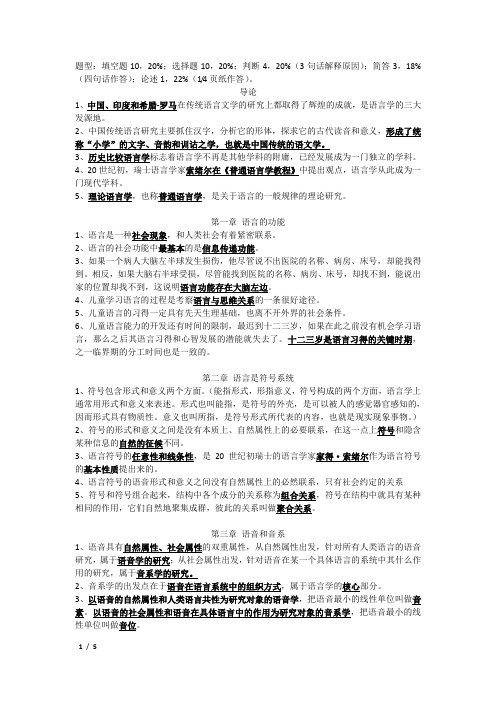
题型:填空题10,20%;选择题10,20%;判断4,20%(3句话解释原因);简答3,18%(四句话作答);论述1,22%(1/4页纸作答)。
导论1、中国、印度和希腊-罗马在传统语言文学的研究上都取得了辉煌的成就,是语言学的三大发源地。
2、中国传统语言研究主要抓住汉字,分析它的形体,探求它的古代读音和意义,形成了统称“小学”的文字、音韵和训诂之学,也就是中国传统的语文学。
3、历史比较语言学标志着语言学不再是其他学科的附庸,已经发展成为一门独立的学科。
4、20世纪初,瑞士语言学家索绪尔在《普通语言学教程》中提出观点,语言学从此成为一门现代学科。
5、理论语言学,也称普通语言学,是关于语言的一般规律的理论研究。
第一章语言的功能1、语言是一种社会现象,和人类社会有着紧密联系。
2、语言的社会功能中最基本的是信息传递功能。
3、如果一个病人大脑左半球发生损伤,他尽管说不出医院的名称、病房、床号,却能找得到。
相反,如果大脑右半球受损,尽管能找到医院的名称、病房、床号,却找不到,能说出家的位置却找不到,这说明语言功能存在大脑左边。
4、儿童学习语言的过程是考察语言与思维关系的一条很好途径。
5、儿童语言的习得一定具有先天生理基础,也离不开外界的社会条件。
6、儿童语言能力的开发还有时间的限制,最迟到十二三岁,如果在此之前没有机会学习语言,那么之后其语言习得和心智发展的潜能就失去了。
十二三岁是语言习得的关键时期,之一临界期的分工时间也是一致的。
第二章语言是符号系统1、符号包含形式和意义两个方面。
(能指形式,形指意义,符号构成的两个方面,语言学上通常用形式和意义来表述。
形式也叫能指,是符号的外壳,是可以被人的感觉器官感知的,因而形式具有物质性。
意义也叫所指,是符号形式所代表的内容,也就是现实现象事物。
)2、符号的形式和意义之间是没有本质上、自然属性上的必要联系,在这一点上符号和隐含某种信息的自然的征候不同。
3、语言符号的任意性和线条性,是20世纪初瑞士的语言学家家得·索绪尔作为语言符号的基本性质提出来的。
英语语言学复习提纲

英语语言学复习提纲一、考试题型1.Define the following terms 2. Fill in the blanks of the following sentences 3. Multiple choices 4. Decide whether the following statements are true or false 5. Draw a tree diagram or a sketch 6. Briefly answer the following questions in three or four sentences 7. Discuss one of the following topics in about 200-300 words二、复习提纲A. 基本概念1. language, linguistics, arbitrariness, duality, creativity, displacement, the divine orgin, the bow-wow theory, the pooh-pooh theory, the yo-he-ho theory, informative function, interpersonal function, performative function, emotive function, phatic function, recreational function, metalanguage function; phonetics, phonology, morphology, syntax, semantics, pragmatics, psycholinguistics, sociolinguistics, anthropological linguistics, computational linguistics, descriptive vs. prescriptive, synchronic vs. diachronic, langue & parole, competence and performance2. three branches of phonetics, names of different parts of speech organ, consonant, different names of consonants, vowels, different names of vowels, IPA, RP, GA, the way to define sounds; segment, coarticulation, phoneme, phonemics, minimal pairs, allophone, complementarty distribution, assimilation, phonological rule, names of phonological rules, underlying form, surface form, distinctive features, syllable structure, stress, onset, coda, intonation, tone, base, root, affixes, compounding3. word order, syntagmatic relations, paradigmatic relations, substitution, co-occurrence, immediate constituent (IC), IC analysis, tree diagram, categories, names of categories, endocentric and exocentric constructions, coordination, subordination, grammatical categories ( number, gender, case, agreement, tense, aspect), phrase, clause, sentence, recursiveness, conjoining, embedding4. meaning, types of meaning, connotation, denotation, reference, referential theory, the semantic triangle, sense relations (synonymy, antonymy, hyponymy), componential analysis, predicate logic, propositional logic, sentence meaning, integrated theory, logical semantics, the truth value table,5. cognition, cognitive linguistics, psycholinguistics, language acquisition, holophrastic stage, two-word stage, construal, categorization, image schemas, metaphor, metonymy, blending theory,6. pragmatics, speaker’s meaning, utterance, context, speech act theory, performatives and constatives, locutionary, illocutionary, perlocutionary acts, conversational implicature, the cooperative principle (CP), relevance theory, the Q- and R-principles, the Q-, I- and M- principlesB. 基本原理1. Why study linguistics?2. What is language?3. What are the design features of language?4. What are the theories for the origin of languge?5. What are the seven functions of language?6. What is linguistics? What are the branches of linguistics?7. What are the distinctions in the study of lingusitcs?8. What are the three branches of phonetics?9. What is phonemics?10. What is phonology?11. How to make IC analysis?12. How to analyze a se ntence or different sentences by using Chomsky’s tree diagrams?13. What are the syntagmatic and paradigmatic relations?14. What are grammatical categories?15. What are the types of meaning?16. What are sense relations?17. What is logical semantics? What is predicate logic? What is propositional logic? What is truth value table?18. What is cognition? What is cognitive linguistics?19. What is language acquisition? What is metaphor and metonymy? What is blending theory?20. How do you understand speech act theory?21. How do you understand the theory of conversational implicature?22. What do you understand the relevance theory?。
语言学复习提纲(完整版)
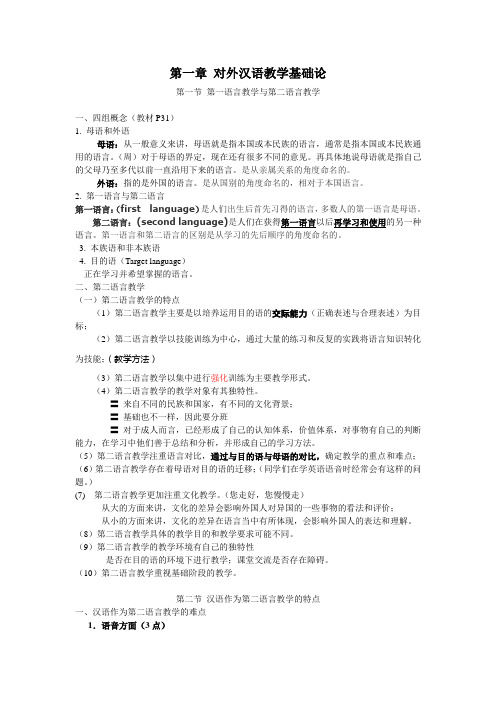
第一章对外汉语教学基础论第一节第一语言教学与第二语言教学一、四组概念(教材P31)1. 母语和外语母语:从一般意义来讲,母语就是指本国或本民族的语言,通常是指本国或本民族通用的语言。
(周)对于母语的界定,现在还有很多不同的意见。
再具体地说母语就是指自己的父母乃至多代以前一直沿用下来的语言。
是从亲属关系的角度命名的。
外语:指的是外国的语言。
是从国别的角度命名的,相对于本国语言。
2. 第一语言与第二语言第一语言:(first language)是人们出生后首先习得的语言,多数人的第一语言是母语。
第二语言:(second language)是人们在获得第一语言以后再学习和使用的另一种语言。
第一语言和第二语言的区别是从学习的先后顺序的角度命名的。
3. 本族语和非本族语4. 目的语(Target language)正在学习并希望掌握的语言。
二、第二语言教学(一)第二语言教学的特点(1)第二语言教学主要是以培养运用目的语的交际能力(正确表述与合理表述)为目标;(2)第二语言教学以技能训练为中心,通过大量的练习和反复的实践将语言知识转化为技能;(教学方法)(3)第二语言教学以集中进行强化训练为主要教学形式。
(4)第二语言教学的教学对象有其独特性。
〓来自不同的民族和国家,有不同的文化背景;〓基础也不一样,因此要分班〓对于成人而言,已经形成了自己的认知体系,价值体系,对事物有自己的判断能力,在学习中他们善于总结和分析,并形成自己的学习方法。
(5)第二语言教学注重语言对比,通过与目的语与母语的对比,确定教学的重点和难点;(6)第二语言教学存在着母语对目的语的迁移;(同学们在学英语语音时经常会有这样的问题。
)(7)第二语言教学更加注重文化教学。
(您走好,您慢慢走)从大的方面来讲,文化的差异会影响外国人对异国的一些事物的看法和评价;从小的方面来讲,文化的差异在语言当中有所体现,会影响外国人的表达和理解。
(8)第二语言教学具体的教学目的和教学要求可能不同。
语言学纲要期末考试重点
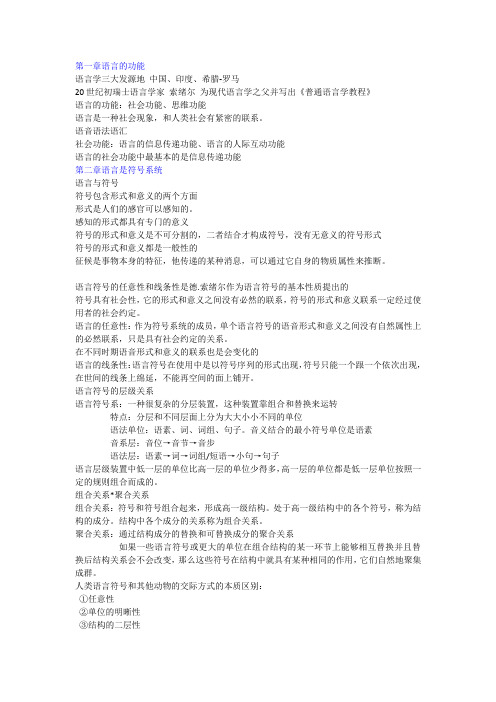
第一章语言的功能语言学三大发源地中国、印度、希腊-罗马20世纪初瑞士语言学家索绪尔为现代语言学之父并写出《普通语言学教程》语言的功能:社会功能、思维功能语言是一种社会现象,和人类社会有紧密的联系。
语音语法语汇社会功能:语言的信息传递功能、语言的人际互动功能语言的社会功能中最基本的是信息传递功能第二章语言是符号系统语言与符号符号包含形式和意义的两个方面形式是人们的感官可以感知的。
感知的形式都具有专门的意义符号的形式和意义是不可分割的,二者结合才构成符号,没有无意义的符号形式符号的形式和意义都是一般性的征候是事物本身的特征,他传递的某种消息,可以通过它自身的物质属性来推断。
语言符号的任意性和线条性是德.索绪尔作为语言符号的基本性质提出的符号具有社会性,它的形式和意义之间没有必然的联系,符号的形式和意义联系一定经过使用者的社会约定。
语言的任意性:作为符号系统的成员,单个语言符号的语音形式和意义之间没有自然属性上的必然联系,只是具有社会约定的关系。
在不同时期语音形式和意义的联系也是会变化的语言的线条性:语言符号在使用中是以符号序列的形式出现,符号只能一个跟一个依次出现,在世间的线条上绵延,不能再空间的面上铺开。
语言符号的层级关系语言符号系:一种很复杂的分层装置,这种装置靠组合和替换来运转特点:分层和不同层面上分为大大小小不同的单位语法单位:语素、词、词组、句子。
音义结合的最小符号单位是语素音系层:音位→音节→音步语法层:语素→词→词组/短语→小句→句子语言层级装置中低一层的单位比高一层的单位少得多,高一层的单位都是低一层单位按照一定的规则组合而成的。
组合关系*聚合关系组合关系:符号和符号组合起来,形成高一级结构。
处于高一级结构中的各个符号,称为结构的成分。
结构中各个成分的关系称为组合关系。
聚合关系:通过结构成分的替换和可替换成分的聚合关系如果一些语言符号或更大的单位在组合结构的某一环节上能够相互替换并且替换后结构关系会不会改变,那么这些符号在结构中就具有某种相同的作用,它们自然地聚集成群。
- 1、下载文档前请自行甄别文档内容的完整性,平台不提供额外的编辑、内容补充、找答案等附加服务。
- 2、"仅部分预览"的文档,不可在线预览部分如存在完整性等问题,可反馈申请退款(可完整预览的文档不适用该条件!)。
- 3、如文档侵犯您的权益,请联系客服反馈,我们会尽快为您处理(人工客服工作时间:9:00-18:30)。
1.INTRODUCTION✧Linguistics is generally defined as the scientific study of language.✧The major branches of linguistics are:(1)Phonetics: it studies the sounds used in linguistic communication;(2)Phonology: it studies how sounds are put together and used to convey meaning incommunication;(3)Morphology: it studies the way in which linguistic symbols representing sounds arearranged and combined to form words;(4)Syntax: it studies the rules which govern how words are combined to formgrammatically permissible sentences in languages;(5)Semantics: it studies meaning conveyed by language;(6)Pragmatics: it studies the meaning in the context of language use.✧If a linguistic study aims to describe and analyze the language people actually use, it issaid to be descriptive.If the linguistic study aims to lay down rules for “correct and standard”, it is said to be prescriptive.Modern linguistics is mostly descriptive.✧The description of a language at some point of time in history is a synchronic study.The description of a language as it changes through time is a diachronic study.In modern linguistics, a synchronic approach seems to enjoy priority over a diachronic one.✧Speech and writing are the two major media of linguistic communication.✧Langue refers to the abstract linguistic system.Parole refers to the realization of langue in actual use.Langue: the abstract linguistic system; shared by all the members; the set of conventions and rules; abstract; stable.Parole: the realization of langue in actual use; concrete use of the conventions and the application of the rules; concrete; varies from person to person, from situation to situation.✧Competence as the ideal user’s knowledge of the rules of his language.Performance the actual realization of this knowledge in linguistic communication.Saussure took a sociological view of language.Chomsky looks at language from a psychological point of view.✧Modern linguistics differs from traditional grammar in several basic ways.(1)Linguistics is descriptive while traditional grammar is prescriptive.(2)Modern linguistics regards the spoken language as primary, not the written.(3)Modern linguistics differs from traditional grammar also in that it does not forcelanguages into a Latin-based framework.✧Language is a system of arbitrary vocal symbols used for human communication.✧Design features: arbitrariness, productivity, duality, displacement, cultural transmission.2.PHONOLOGY✧Speech and writing are the two media or substances used by natural languages asvehicles for communication.Of the two media of language, speech is more basic than writing.✧This limited range of sounds which are meaningful in human communication constitutethe phonic medium of language.The individual sounds within this range are the speech sounds.✧Three branches of phonetics are: articulatory phonetics, auditory phonetics, andacoustic phonetics.✧Three important areas: the pharyngeal cavity– the throat, the oral cavity– the mouth,and the nasal cavity– the nose.✧Broad transcription– the transcription with letter-symbols only.Narrow transcription– the transcription with letter symbols together with the diacritics.aspirated – pit, unaspirated – spit.✧Speech sounds divide into two broad categories: vowels and consonants.✧Classification of English consonants --(1)In terms of manner of articulationStop: [p] [b] [t] [d] [k] [g]Fricatives: [f] [v] [s] [z] [θ] [ð] [ʃ] [З] [h]Affricates: [ʧ] [ʤ]Liquids: [l] [r]Nasals: [m] [n] [η]Glides: [w] [j](2)In terms of place of articulationBilabial: [p] [b] [m] [w]Labiodental: [f] [v]Dental: [θ] [ð]Alveolar: [t] [d] [s] [z] [n] [l] [r]Palatal: [ʃ] [З] [ʧ] [ʤ] [j]V elar: [g] [η]✧Classification of English vowels –V owel sounds are differentiated by a number of factors: the position of the tongue in themouth, the openness of the mouth , the shape of the lips, and the length of the vowels.(1)The tongue in the mouth: front ([i:] [i] [e] [æ] [ɑ]), central ([ɜ:][ə] [ʌ]), and back([u:][u][ɔ:] [ɒ] [ɑ:]).(2)The openness of the mouth: close vow els([i:] [i] [u:] [u]), semi-close([e][ɜ:]),semi-open ([ə][ɔ:]), open vow els ([æ] [ɑ] [ʌ] [ɒ] [ɑ:]).(3)The shape of the lips: unrounded vowels: all the front vowels and the centralvowels. rounded vowels: all the back vowels, with the exception of [ɑ:].(4)The length of the vowels: corresponding to the distinction of long and shortvowels is the distinction of tense and lax vowels.✧What is a phone? How is it different from a phoneme? How are allophones related toa phoneme?A phone is a phonetic unit or segment. The speech sounds we hear and produce duringlinguistic communication are all phones. A phoneme is not any particular sound, but rather it is represented or realized by a certain phone in a certain phonetic context. The different phones which can represent a phoneme in different phonetic environments are called the allophones of that phoneme. For example, the phoneme /l/ in English can be realized as dark [ɫ], clear [l], etc. Which are allophones of the phoneme /l/.✧Two distinctive phonemes are said to form a phonemic contrast, e.g. /p/ and /b/ in [pit],[rəup]and [rəub].For instance, the clear [l] always occurs before a vowel while the dark // always occurs between a vowel and a consonant, or at the end of a word. So the allophones are said to be in complementary distribution.When two different forms are identical in every way except for one sound segment which occurs in the same place in the strings, the two sound combinations are said to form a minimal pair. e.g. pill and bill, pill and till, till and kill, kill and dill, and dill and gill.✧Explain with examples the sequential rule, the assimilation rule, and the deletion rule.Rules that govern the combination of sounds in a particular language are called sequential rules. For example, if a word begins with a [l] or a [r], then the next sound must be a vowel. That is why [lbik] [lkbi] are impossible combinations in English.The assimilation rule assimilates one sound to another by “copying” a feature of a sequential phoneme, thus making the two phones similar. For example, the [i:] sound is nasalized in words like bean, green, team, and scream. This is because in all these sound combinations the [i:] sound is followed by a nasal [n] or [m].Deletion rule tells us when a sound is to be deleted although it is orthographically represented. For example, words as sign, design, and paradigm, there is no [g] sound although it is represented in spelling by the letter g. but in their corresponding forms signature, designation, and paradigmatic, the [g] represented by the letter g is pronounced. The rule can be stated as: Delete a [g] when it occurs before a final nasal consonant.✧The phonemic features that occur above the level of the segments are calledsuprasegmental features. The main suprasegmental features include stress, intonation, and tone.(1)The location of stress in English distinguishes meaning. There are two kinds ofstress: word stress and sentence stress. The noun has the stress on the first syllable and the corresponding verb has the stress on the second syllable.(2)Tones are pitch variations which can distinguish meaning just like phonemes.English is not a tone language. Chinese is a typical tone language.(3)When pitch, stress and sound length are tied to the sentence rather than the word inisolation, they are collectively known as intonation.English has for basic types of intonation: the falling tone, the rising tone, the fall-rise tone, and the rise-fall tone.3.MORPHOLOGY✧In English, nouns, verbs, adjectives and adverbs are the content words of a language,which are sometimes called open class words, since we can regularly add new words to these classes.Conjunctions, prepositions, articles and pronouns consist of relatively few words and have been referred to as being closed class words since new words are not usually added to them.✧Morphology thus refers to the study of the internal structure of words, and the rules bywhich words are formed.✧The most basic element of meaning is traditionally called morpheme.✧It occurs only before other morphemes, such morphemes are called prefixes. e.g. un-,dis-.Other morphemes occurs only as suffixes, i.e. only after other morphemes. e.g. -or, -er,, -ful.✧When they are conjoined to other morphemes (or words) a new word is derived, orformed, thus called derivational morphemes. e.g. –en (adj.->v. black+en), -ate (n. ->adj.affection+ate), and –ic (n.->adj. alcohol+ic).✧There are bound morphemes which are for the most part purely grammatical markers.Such bound morphemes are referred to as inflectional morphemes. They are attached to words or morphemes, but they never change their syntactic category.✧The ways words are formed are called morphological rules. These rules determinehow morphemes combine to form words.✧Some of the morphological rules can be used quite freely to form new words. W e callthem productive morphological rules.✧Such a rule can be stated as: un + adjective = not – adjective✧Morphological rules may thus be productive or less productive.✧When we form compounds, the following points are noteworthy:(1)When the two words are in the same grammatical category, the compound will bein this category. e.g. noun + noun (post box, landlady), adjective + adjective(blue-black, icy-cold)(2)In many cases, the two words fall into different categories. Then the class of thesecond or final word will be the grammatical category of the compound. e.g.noun + adjective (head-strong), verb + noun (pickpocket)(3)Compounds have different stress patterns from the noncompounded wordsequence.(4)The meaning of a compound is not always the sum of the meanings of its parts.✧Compounding is then a very common and frequent process for enlarging the vocabularyof the English language.5.SEMANTICS✧Semantics can be simply defined as the study of meaning.✧What are the major views concerning the study of meaning?(1)One of the oldest notions concerning meaning, and also the most primitive one,was the naming theory proposed by the ancient Greek scholar Plato.(2)The conceptualist view–relates words and things through the mediation ofconcepts of the mind.This is best illustrated by the classic semantic triangle or triangle of significancesuggested by Ogden and Richards.(3)The contextualism–J. R. Firth –Every utterance occurs in a particularspatiotemporal situation, the main components of which include, apart from theplace and time of the utterance, the speaker and the hearer, the actions they areperforming at the time, the various objects and events existent in the situation.(4)The behaviorism– Bloomfield – situation in which the speaker utters it and theresponse it calls forth in the hearer.✧Sense and referenceSense is concerned with the inherent meaning of the linguistic form. It is the collection of all the features of the linguistic form; it is abstract and de-contextualized.Reference means what a linguistic form refers to in the real, physical world; it deals with the relationship between the linguistic element and the non-linguistic world of experience.✧Synonymy refers to the sameness or close similarity of meaning. Words that are closein meaning are called synonyms.✧What are the major types of synonyms in English?The major types of synonyms are dialectal synonyms, stylistic synonyms, emotive or evaluative synonyms, collocational synonyms, and semantically different synonyms.✧While different words may have the same or similar meaning, the same one word mayhave more than one meaning. This is what we call polysemy, and such a word is calleda polysemic word.✧Homonymy refers to the phenomenon that words having different meanings have thesame form.(1)When two words are identical in sound, they are homophones. e.g. rain, reign;night, knight; piece, peace; leak, leek.(2)When two words are identical in spelling, they are homographs. e.g. bow v.,bow n.; tear v., tear n.; lead v., lead n.(3)When two words are identical in both sound and spelling, they are completehomonyms. e.g. fast adj., fast v.; scale n., scale v.✧Hyponymy refers to the sense relation between a more general, more inclusive word anda more specific word.The word which is more general in meaning is called the superordinate, and the more specific words are called its hyponyms.Hyponyms of the same superordinate are co-hyponyms.✧The term antonymy is used for oppositeness of meaning; words that are opposite inmeaning are antonyms. (gradable antonyms, complementary antonyms, relationalopposites)✧Componential analysis is a way proposed by the structural semanticists to analyze wordmeaning.The approach is based upon the belief that the meaning of a word can be dissected into meaning components, called semantic features.✧In G. Leech’s framework of analysis, the basic unit is called predication, which is theabstraction of the meaning of a sentence.A predication consists of argument(s) and predicate.An argument is a logical participant in a predication, largely identical with the nominal element(s) in a sentence. A predicate is something said about an argument or it states the logical relation linking the arguments in a sentence.。
